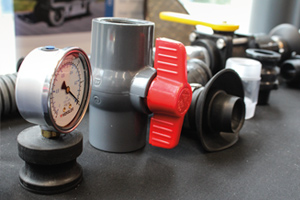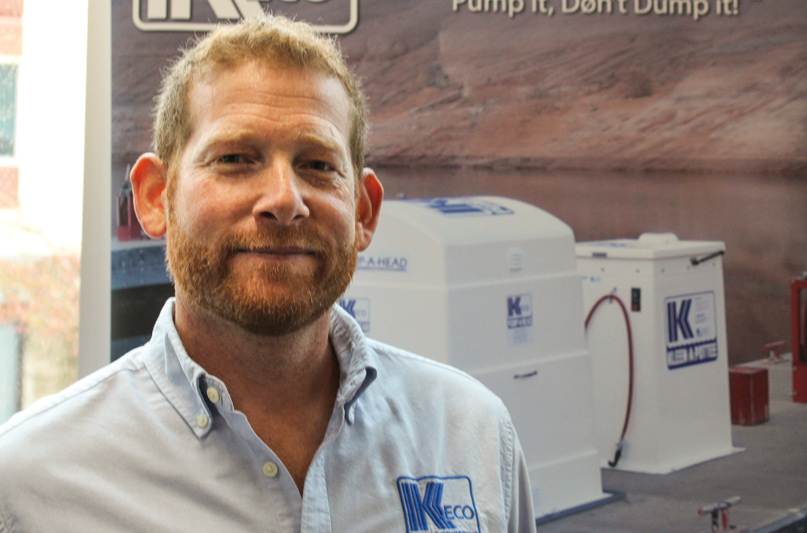“Ninety-nine percent of all failures come
from people who have a habit of making excuses.”
— George Washington Carver
For boaters with a holding tank, the ritual of pumping out is usually embraced with emotions ranging from mild annoyance to hyperbolic disgust to joy (if there’s an overflowing blackwater tank that’s steeped for a week aboard).
Regardless of one’s personal feelings on the matter, there’s no denying that pumping out is a fact of boating life, especially during these environmentally conscious times in these environmentally conscious Pacific Northwest waters. One only need look at the recently mandated Puget Sound-wide No Discharge Zone and compare it to the decades of yore when having blackwater tanks was optional to see which way the trend is going.
But what’s really going on in a pump-out station, machinery-wise? Is it basically a big Hoover vacuum, or something else? Where do the goods go, exactly?
To get answers, I travelled to the 2019 Northwest Marina & Boatyard Conference hosted in Bremerton, Washington, to talk to a pump-out pro. Alex Bleier is a co-owner of KECO Pump & Equipment and head of the Marine Division of the company. I caught him before a presentation about pump-out systems for marina managers.
NWY: When we’re talking about KECO pumps, we’re talking about large powerful systems for whole marinas, correct?
Yes. These units tend to be in mom and pop marinas, large municipal marinas, and commercial docks. The main purpose is to help prevent sewage being spilled into our public waterways. The goal here is to put equipment in, make sure it’s accessible to the public, and make sure we’re all being good stewards of the environment.
NWY: So how do most pump-out station pumps work, exactly?
Basically, there’s three styles of equipment. We’ve got fixed units that are probably the most common at the end of fuel or
service docks. That’s what boaters recognize at their local pump-out station in the marina, and they come in different packages and sizes.
Secondly, we have portable units that can be pushed around in mobile carts for pump-out boats. Finally, we have centralized systems that are emerging as the most common new construction type of system. This is where we install pump-out hydrants at each slip. Those are the basic different user interfaces.
But let’s focus on the classic fixed unit where the boater shows up and parks their boat. We try to keep the equipment as simple and straightforward as possible. This means putting a simple on and off button on there and an easy-to-use suction hose with instructions that are very simple.
The real magic is what is under the cover, or what’s being used to get the sewage out of the boat. Technology has shifted over the last 20 or 30 years, so now we’re using modern peristaltic pumps. Peristaltic pumps are the most common type of pumps we use today because it’s very simple and capable design.
Not only are they good at getting suction to get waste out of boats, but as soon as we get it out of the boats, we want to dispose of the waste. So, we’re going to push the waste back to land to municipal sewage systems and private septic tanks. Sometimes these things aren’t nearby, sometime hundreds or thousands of feet or even miles over land. Our pumps today are very capable and can even push the waste miles onto land with high elevation differences.
NWY: So peristaltic pumps are dominant, but are there other kinds of pumps in the game?
KECO Pump & Equipment developed the first commercially available pump-out system brought to market, and the technology at the time was using diaphragm pumps. They work like our heart where you have a mechanically driven plunger moving up and down with associated valves that open and close. We still use that technology today, and from an affordability standpoint, it’s the most affordable type of system. I’d rate diaphragm pumps as good while peristaltic pumps are best.
There are also traditional vacuum pumps, although we’re starting to phase those types of units out. They’ve got complexities with electronics, and lots of complicated valving, probes, and sensors. Maintenance is a big deal with vacuum systems, and we’re dealing with salty marine environments, sometimes harsh winters, UV, you name it. It’s a harsh environment and we want equipment that’s easy to maintain.
NWY: How does maintenance play into pump out equipment use and ownership?
Maintenance is the big ticket; you need to get people to go down there and maintain these things. There’s a negative cloud that can hang over a waste water system because it deals with fecal matter, a ‘I don’t want to go down and touch it’ attitude. That’s why sometimes maintenance is neglected. That’s a big reason why we’ve shifted toward peristaltic pumps because there’s more of a set it and forget it type mentality.
Importantly, the visual characteristics of a pump-out system is something to consider. We want people to wipe the bird droppings off. We want people to coil the hoses and make them look attractive and easy to use.
Of course, maintenance also means pulling the cover off and looking for rust, odd sounds, oil that may be spilling out, and the like. We send out maintenance checklists as part of our support to customers. But the life cycle of these units average about 10 years and there are units that have 30 or 40 years on them still in service. We’ve got others that may last more like five years if exposed to really harsh environments without regular maintenance.
NWY: Do you have any insider tips with regards to red flags for boaters?
Usually the visual is a good indicator as to what that unit is going to do. If they look poorly maintained, they are probably going to perform poorly.
A lot of states now have grant programs to pay for this equipment because they want to create a better world for the boater community. A lot of states even have apps or you can go online to find out where the nearest pumpout is. Some are even putting in a feedback element to it where boaters can, sort of like a Yelp review, review how well the pump-out station worked for them.
NWY: Can you speak to a Pacific Northwest culture on the topic of pump-outs?
My impression is that those in the Pacific Northwest are very forward thinking and have a really solid grant program. So in that sense, they’re putting a lot of equipment out there for the boating community. They’re awesome at outreach.
For example, Washington Sea Grant has been doing a great job with things like putting educational pump-out videos online. I’ve even heard that they have a program where they’re giving out free pump-out adaptors, which gives individual boaters a unique, user friendly relationship to the pump. I think it can feel less gross, for lack of a better term, giving boaters their own adaptor so they’re not sharing with everybody else.
NWY: We’ve talked a bit about the past and present, but is there anything exciting in store for the future of pump-out equipment?
It’s funny you bring that up. Centralized systems are really the way the industry is shifting. It’s not so easy to retrofit a marina to do a whole new construction, but that’s where we’re bringing out the pumps to individual slips. With a centralized system, the marina tenant doesn’t just have shore power to plug into and water access, but they also have basically a shore power sewer right there in the slip. It’s not a new concept, but we’re building on it.
The modern pumps are stronger and have more power and piping associated with them. Technology we first introduced about 10 years ago made it so we can start these pumps wirelessly, so we don’t have to run conductive wiring throughout the marina anymore. That’s good because that wiring goes bad overtime.
We also have telemetry-based products that monitor the equipment to know how many hours are on the units, how many cycles, how often they’re being used, when they’re being used, and more. But most importantly, these products can also alert the marina when systems are down. Rather than waiting for that Fourth of July weekend call from an upset boater that the pump-out station isn’t working, the marina operator will know ahead of time that the pump lost power, there’s a leak detected in the system, etc.
In terms of advancement, we are moving forward. Pump technology doesn’t shift very quickly, but the components are updated and modernized constantly. We’ve got a lot of experience outside of the marine industry, which builds upon our expertise in this sphere.
NWY: For marina managers overseeing a pump-out system, when is it time to consider an upgrade or next step?
Firstly, find out when your equipment was purchased. Look at the age, in addition going down there physically to look at the equipment, including the aesthetics like we mentioned, but also under the cover. Keeping prepared replacement parts on hand is critical. It is always at the most inopportune time when these units have a failure.
If you find that you’re throwing a lot of money into repairing these units, it may be time to replace them. Saving up or trying to budget for a capital improvement or budget project is usually a part of this, for most marinas when their pumpout breaks, they aren’t totally ready financially to pull the trigger immediately and buy a new one. They have to budget, and that process can likely take six months to a year. You really want to forecast these units.
Also, you want to get feedback from the boaters. This the most critical thing; that the boaters have a voice. If a boater is in a marina and the pumpout isn’t working, he or she should tell the harbormaster or the dockmaster.
The critical part is— if there is a high-density population of boaters and they don’t feel like there is a pumpout nearby, they should reach out to their state. Grant coordinators exist in a lot of water-bound states.
For example, Washington has a grant coordinator. If there’s a reason to get a pumpout in an area that provides better convenience to the boaters, and if the community makes it known, there’s likely to be a response.

